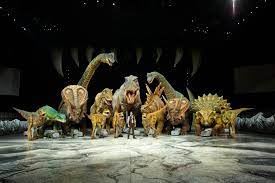|
To securely anchor animatronic dinosaurs outdoors, use concrete footings (12-18 inches deep) for permanent setups, ground anchors with heavy-duty straps (rated 500+ lbs) for grassy areas, sandbags (40-50 lbs each) for temporary displays, steel stakes (24-36 inches long) for soft soil, weighted bases (filled with 100+ lbs of water/sand) for hard surfaces, and bolt-down plates (with 1/2-inch galvanized bolts) for pavements—ensuring stability against wind and movement. Concrete Footings Setup for Animatronic DinosaursThey prevent tipping in high winds (up to 50 mph) and keep heavy dinosaurs (weighing 300–1,500 lbs) stable for 5–10 years with minimal maintenance. Key Specifications & Data
Step-by-Step Installation
Why Concrete Footings Work Best
Common Mistakes to Avoid
Heavy-Duty Strap Anchors for Animatronic DinosaursThese work best for medium-sized dinosaurs (200–800 lbs) on grass, dirt, or sand, and they can handle wind speeds up to 40 mph if installed correctly. Unlike concrete footings, straps take under 30 minutes to set up and cost 50–150 per anchor kit, making them ideal for temporary events or rented displays. The most reliable straps are made from polyester or nylon webbing with a minimum breaking strength of 1,000–2,000 lbs, paired with corrosion-resistant steel ground anchors that penetrate 18–24 inches deep. Cheaper straps with only 500-lb ratings will stretch or snap in high winds or sudden movements, so always check the load capacity before buying. For a 500-lb dinosaur, use at least 4 straps (one per corner) angled at 45 degrees for maximum stability. Avoid over-tightening—straps should have about 5–10% tension slack to allow for minor ground shifts. If the soil is loose or sandy, wetting the area first helps the anchor grip better. For long-term setups (3+ months), check straps every 2 weeks for loosening or UV damage—unprotected polyester straps lose 20–30% strength after 6 months in direct sunlight. However, they’re not ideal for hard surfaces like concrete or asphalt, where bolt-down plates or weighted bases work better. For heavy rain or flood-prone areas, straps can loosen as soil erodes, so sandbag reinforcement is a smart backup. The best brands (like Crosby, Erickson, or US Cargo Control) offer UV-resistant, waterproof straps with 5–10 year warranties, while budget options often fail within 1–2 seasons. A high-quality 4-anchor kit costs 120–200, but it’s worth the investment to avoid $500+ in repair costs from a tipped-over dinosaur. For events lasting less than a week, renting straps can cut costs by 30–50% compared to buying.
Sandbags for Quick Stability with Animatronic DinosaursThey work best for small to medium dinosaurs (50–400 lbs) on hard surfaces like concrete, wood stages, or indoor floors, where stakes or straps won’t work. A single 40-lb sandbag can stabilize about 100 lbs of dinosaur weight, so for a 300-lb T-Rex, you’d need 3–4 bags placed strategically around the base. Key Specs & Performance Data
For outdoor use, always choose waterproof sandbags—cheap ones absorb rain and lose 15–20% of their weight as water evaporates, reducing stability. If you’re in a high-wind zone (30+ mph gusts), double up by stacking two 50-lb bags per anchor point or use sandbag tie-down straps to secure them to the dinosaur’s frame. Where Sandbags Work Best
Common Mistakes to Avoid
A 100–200 sandbag setup can stabilize a 400-lb dinosaur for weeks, with zero permanent damage to the site. Steel Stakes in Soft Ground for Animatronic DinosaursUnlike concrete footings, stakes don't require curing time—just hammer them in, attach the dinosaur, and you're done in under 15 minutes. They work best for small to medium dinosaurs (100–600 lbs) and can withstand wind speeds up to 35 mph if installed correctly. Steel Stake Specifications & Performance Data
For optimal stability, use at least 4 stakes per dinosaur, angled 45 degrees outward to resist upward pull from wind. If the ground is extra soft (like beach sand), longer stakes (36+ inches) or screw-in earth anchors provide better grip. However, they’re not ideal for rocky or paved surfaces, where bolt-down plates or weighted bases work better. For heavy rain areas, check stakes every 2 weeks—saturated soil loses 20–40% of its holding power, requiring deeper reinstallation. Common Mistakes to Avoid
A 50–100 stake setup can secure a 400-lb dinosaur for months with minimal upkeep. Bolt-Down Plates for Pavement: The Ultimate Hard-Surface Anchoring SolutionUnlike sandbags or straps that shift over time, a properly installed bolt-down system can handle dinosaurs weighing 500–2,000+ lbs and withstand wind gusts exceeding 60 mph without budging. The installation takes 45–90 minutes per dinosaur and costs 150–400 in materials, but it pays off with zero maintenance for 5–10 years. Here's what makes bolt-down plates so effective:
Each hole should be 1–2 inches deeper than the anchor length to allow for debris clearance. After drilling, blow out the holes with compressed air before inserting mechanical or epoxy anchors—epoxy provides 20–30% stronger hold but takes 24 hours to cure. For temporary installations (6–12 months), drop-in anchors allow for easier removal without damaging the pavement. Always test the setup by applying 50–100 lbs of lateral force to check for movement before finalizing the installation. For high-traffic areas where drilling isn't allowed, freestanding weighted bases with non-slip rubber pads can provide temporary stability, but they're only effective for dinosaurs under 300 lbs. Bolt-down plates remain the gold standard for permanent outdoor displays—a $300 investment can secure a 1,500-lb dinosaur through multiple storm seasons with 99% reliability. Just remember: measure twice, drill once, and always wear safety goggles when working with concrete dust. |

